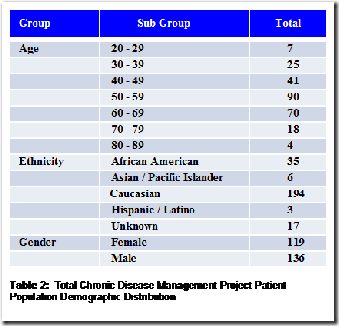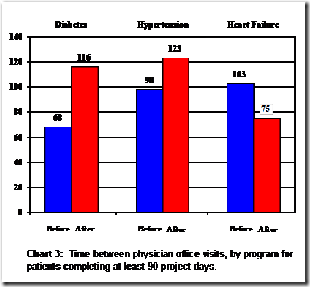I first posted about the project back November of 2008 and now we are beginning to see some numbers result. The Epic records system used by Cleveland Clinic  connects to Microsoft HeatlhVault and thus the patients have the flexibility of adding information via HealthVault and sending it to MyChart. The physicians were able to view and analyze using MyPractice and work together with patients. One item to make note of here, nobody is perfect and we had no 100% compliance here as we are all humans so don’t expect that number to be a reality as we all have lives to live too, but an improvement can be expected if you have a proper implementation and know up front how the game will be played for better care and information.
connects to Microsoft HeatlhVault and thus the patients have the flexibility of adding information via HealthVault and sending it to MyChart. The physicians were able to view and analyze using MyPractice and work together with patients. One item to make note of here, nobody is perfect and we had no 100% compliance here as we are all humans so don’t expect that number to be a reality as we all have lives to live too, but an improvement can be expected if you have a proper implementation and know up front how the game will be played for better care and information.
Below is a video of a truck driver who takes his reading on the road and at home so you can hear directly from him on how he is working with the technology. Again he works it around his schedule of driving a truck and his convenience without stopping the truck to respond if it is not necessary. This is important to make note of as we all achieve for high goals but as some may expect 100% compliance, it’s not going to happen, but improvement will. With all the talk on meaningful use, the wireless part of the equation is being highly overlooked in some areas and how it needs to coordinate with participatory sensing as well as participatory engagement of the patient/doctors. BD
Cleveland Clinic and Microsoft HealthVault to track chronic diseases at home with Medical Devices
Gisela Nehring, R.R.T., Olga Rodriguez, R.N., R. Joseph Turk,
Rami Boutros, M.D., Gene Lazuta, C. Martin Harris, M.D.
The following case study describes a project conducted by Cleveland Clinic and the MicrosoftTM Corporation that was designed as a first step toward understanding how skilled medical professionals and their patients can cooperatively use specially-designed, health information technology systems to securely acquire and share the information needed to support true, physician-directed chronic disease monitoring and management. This was not a scientific study; instead it was envisioned as a way to test the concept that human beings can use technology-based tools to change what is today an episodic style of medical management, based on regularly scheduled visits conducted in a doctor’s office, to a continuous management model composed of multiple data points describing, in detail, a patient’s progress over time.
Cross Country Truck Driver using Microsoft HeatlhVault to send blood pressure readings to his doctor
| Checking blood pressure |
At Cleveland Clinic, all aspects of medical care is technology-enabled and supported through a secure, electronic medical record (EMR) system composed of a large number of integrated modules from Epic Systems that, taken together, is called MyPractice.® Every physician, nurse, pharmacist, associated medical support person and administrative specialist in all of Cleveland Clinic’s 11 hospitals and 13 Family Health Center locations are connected by the MyPractice system, which features a set of tools ranging from computerized physician order entry to automated physician alerts and reminders. Connected to this system is a secure Internet-based patient service called MyChart,® which allows patients to view portions of their electronic medical record, including past appointments, physician instructions, test results, and personalized health-related educational materials; MyChart also provides patients the opportunity to schedule future appointments, request prescription renewals, and receive reminders when routine preventive health activities such as mammograms and HBA1c screenings are due.
Linked to the MyPractice electronic medical record system and MyChart was Microsoft’s HealthVault,® a secure Internet-based service that allows patients to download the objective data generated by a number of at-home digital medical devices into a HeatlhVault portal which interfaces with Cleveland Clinic’s EMR. One of the advantages of HealthVault to patients and physicians is its ability to electronically interface, or “talk to,” a number of different digital medical devices and electronic medical record systems. With HealthVault, patients participating in the project were able to use their home computer, connected to the Internet, to deliver device-generated data about themselves directly from the device, to HealthVault, the data was then pulled into the patient’s electronic medical record where a Cleveland Clinic physician could review and, if necessary, act upon it.
Supporting the Microsoft / Cleveland Clinic technology-enabled chronic disease management project were physicians from the Cleveland Clinic Heart and Vascular Institute (heart failure), Endocrinology and Metabolism Institute (diabetes), and the Glickman Urological and Kidney Institute (hypertension).
The recruitment process began in December of 2008, and continued through October of 2009, generating a final program patient population of 255 individuals (see Table 1). Overall, the recruitment success rate ran at approximately 1.6 patients approached for every one who agreed to participate. Of the total patient population, 26% participated in the diabetes program, and were followed by 8 physicians; 6% participated in the heart failure program, and were followed by 3 physicians; and 68% participated in the hypertension program, and were followed by 36 physicians. The age, gender, and ethnicity of the patient participants varied fairly broadly, and is described in Table 2. Also, the length of time patients spent in the program varied according to when they were recruited, which affects several activity and effect results.
1. As indicated by Chart 2, not a single patient in any of the program categories was 100% compliant with the type and frequency of readings prescribed by their physician.
Considering that the patients included in this chronic disease management project voluntarily agreed to participate, often at the suggestion of their physician, it may be interesting to note that no patient successfully achieved complete compliance with the reading types and reading frequency-per-day recommended by their physician.
Also note-worthy: while Chart 1 indicates that the hypertensive patient population had the highest percentage of “light” technology users, when usage is matched against physician instructions, hypertensive patients were those who most closely approached their goals. And where diabetic patients achieved a 52% compliance rate, heart failure patients—arguably the most acutely ill of the patient participant groups—produced compliance averages below 50% for both daily blood pressure and weight readings.
2. As indicated by Chart 3, each program demonstrated a noticeable change in the average number of days between physician office visits. For diabetic and hypertensive patients, the days between office visits increased by 71% and 26%, respectively. For heart failure patients the number of days between physician office visits decreased by 27%, going from an average of 103 to 75 days.
Reducing and managing blood glucose levels for diabetics and blood pressure for hypertensive patients can help reduce the complications caused by ongoing damage to their body’s tissues and cells. Commonly, diabetic and/or hypertensive patients visit their physicians approximately once every 90 to 120 days, at which time blood glucose and/or blood pressure readings are recorded. But diabetes and hypertension are “every day” diseases, and the ability of a physician to monitor an ongoing, continuous set of data points related to a patient’s condition could potentially:
· Result in a decrease in the number of office visits for patients who are managing their disease well and therefore do not need to see their physician as often
Provide the physician the ability to arrange a timely intervention with a patient unsuccessfully managing their condition, thereby mitigating potential complications by minimizing the time a patient spends at increased risk due to elevated blood glucose and/or blood pressure
By providing physicians the ability to reliably monitor heart failure patients’ daily weight, blood pressure, and activity levels, health information technology systems could potentially serve to increase the timeliness of the physician-directed interventions that may circumvent the more serious, and expensive issues that often result when smaller problems are not addressed.
Summation
Our experience with the Microsoft / Cleveland Clinic technology-enabled chronic disease project suggests that it may be possible to reconceive the model used to care for chronic disease patients from a model centered around encounters that occur in a physician’s office to a model or models based on more continuous assessment, with physician interventions facilitated through the use of home and office health information technology tools. As we think about the growing demand for chronic disease services, and the relatively finite supply of physicians, this remote but coordinated model of care might relieve the predicted bottleneck in access to physicians for more acute issues, while maintaining or improving care for patients who have relatively stable chronic conditions.
Previous studies have shown that a more continuous management model of chronic disorders can result in better outcomes for patients. These studies were done using human resources (nurses and other allied health professionals) and although successful, they were found to be cost prohibitive. The types of technology tools used in the Microsoft / Cleveland Clinic technology-enabled chronic disease management project may allow us to address the cost issues related to chronic disease management of large populations. A rigorous scientific study of these technologies and how they might be used in new care delivery models may yield important insights into designing effective chronic disease management models in the future






Very good post. I have been searching for this post since many days. Now I have implemented the same for my site.
ReplyDeleteThe history of the Medical sciences is replete with episode after episode in which the discoveries of science, subversive as they were because they undermined existing knowledge, had a hard time achieving acceptability and respectability.
ReplyDeleteScience is an intellectual activity carried on by humans that is designed to discover information about the natural world in which humans live and to discover the ways in which this information can be organized into meaningful patterns.
ReplyDelete